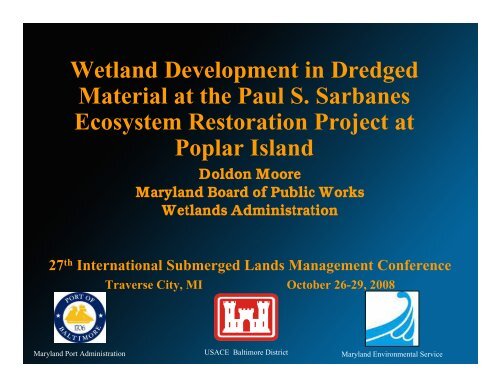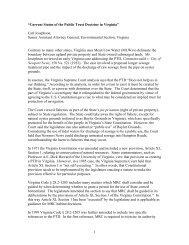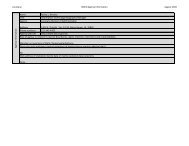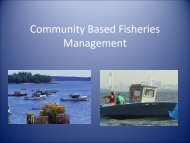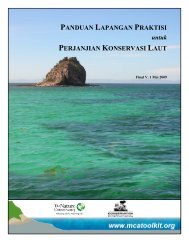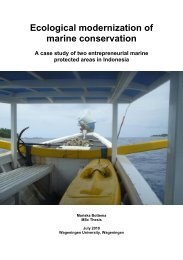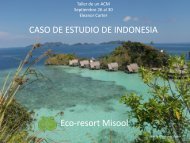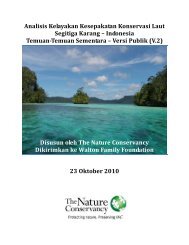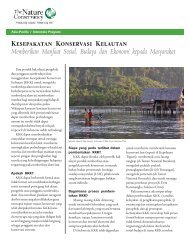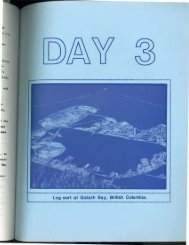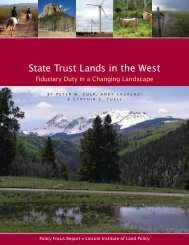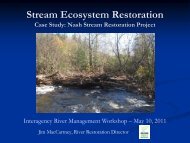the Paul S. Sarbanes Ecosystem Restoration Project at Poplar Island
the Paul S. Sarbanes Ecosystem Restoration Project at Poplar Island
the Paul S. Sarbanes Ecosystem Restoration Project at Poplar Island
You also want an ePaper? Increase the reach of your titles
YUMPU automatically turns print PDFs into web optimized ePapers that Google loves.
Wetland Development in Dredged<br />
M<strong>at</strong>erial <strong>at</strong> <strong>the</strong> <strong>Paul</strong> S. <strong>Sarbanes</strong><br />
<strong>Ecosystem</strong> <strong>Restor<strong>at</strong>ion</strong> <strong>Project</strong> <strong>at</strong><br />
<strong>Poplar</strong> <strong>Island</strong><br />
Doldon Moore<br />
Maryland Board of Public Works<br />
Wetlands Administr<strong>at</strong>ion<br />
27 th Intern<strong>at</strong>ional Submerged Lands Management Conference<br />
Traverse City, MI October 26-29, 2008<br />
Maryland Port Administr<strong>at</strong>ion<br />
USACE Baltimore District<br />
Maryland Environmental Service
Overview<br />
• Background<br />
• Wetland Development<br />
• Lessons Learned<br />
• Monitoring
<strong>Paul</strong> S. <strong>Sarbanes</strong> <strong>Ecosystem</strong> <strong>Restor<strong>at</strong>ion</strong><br />
<strong>Project</strong> <strong>at</strong> <strong>Poplar</strong> <strong>Island</strong><br />
• Dredged m<strong>at</strong>erial placed from Baltimore Harbor Approach<br />
Channels<br />
• <strong>Island</strong> restor<strong>at</strong>ion will re-establish <strong>the</strong> approxim<strong>at</strong>e 1847 footprint
<strong>Project</strong> Loc<strong>at</strong>ion<br />
Mid-<br />
Chesapeake Bay,<br />
Maryland<br />
Talbot County
Tilghman <strong>Island</strong><br />
<strong>Poplar</strong> <strong>Island</strong><br />
2000<br />
Coaches <strong>Island</strong><br />
Jefferson <strong>Island</strong><br />
South Central<br />
<strong>Poplar</strong> <strong>Island</strong><br />
Middle<br />
<strong>Poplar</strong> <strong>Island</strong><br />
Sunken Barges<br />
North Point<br />
South
Landmass Comparison 1847-1993
<strong>Poplar</strong> <strong>Island</strong> Specific<strong>at</strong>ions<br />
• Size: 1,140 acres<br />
• Perimeter dike: 40,000 ft<br />
• Capacity: 42 mcy<br />
• Cost: $407 million<br />
• Uplands: 570 acres (50%)<br />
• Wetlands: 570 acres (50%)<br />
• To d<strong>at</strong>e, approxim<strong>at</strong>ely 13 mcy<br />
dredged m<strong>at</strong>erial placed<br />
• <strong>Project</strong>ed placement life until 2015
<strong>Poplar</strong> <strong>Island</strong> Site Development<br />
EAST<br />
Cell 6<br />
west<br />
• 6 Large Containment Cells: 4 Wetland Cells & 2 Upland Cells<br />
• Wetland Cells Temporarily Divided via Interior Dikes<br />
• Wetland Cells- 80% Low Marsh & 20% High Marsh
• Wetland Cell “3D”<br />
• 32 acres<br />
Wetland Cell Development
Wetland Cell Development<br />
Wetland Cell Development is a<br />
Four Phase Process:<br />
• Inflow and Crust Management<br />
• Grading and Channel Development<br />
• Inlet Structure Construction<br />
• Planting
Wetland Cell Development<br />
Inflow and Crust Management: April ‘01-Nov. ‘03<br />
•0.35 million cubic yards<br />
(mcy) of dredged m<strong>at</strong>erial<br />
inflowed into Cell 3D<br />
•Crust develops from<br />
dew<strong>at</strong>ering methods<br />
•Goal was to maximize<br />
consolid<strong>at</strong>ion and achieve <strong>the</strong><br />
appropri<strong>at</strong>e elev<strong>at</strong>ions
Crust Management<br />
Desicc<strong>at</strong>ion Cracks<br />
Pontoon trencher<br />
Pontoon Excav<strong>at</strong>or
Wetland Cell Development<br />
Grading & Channel Development: Dec. ‘03-Oct. ‘04<br />
Channel Excav<strong>at</strong>ion<br />
•M<strong>at</strong>erial excav<strong>at</strong>ed from channels was redistributed by grading<br />
•High Marsh elev<strong>at</strong>ions: Approxim<strong>at</strong>ely +2.2 ft<br />
•Low marsh: Approxim<strong>at</strong>ely +1.5 ft
Wetland Cell Development<br />
Inlet Structure Construction: Dec. ’04 – Jan. ‘05<br />
Pipes allow<br />
tidal interaction<br />
Weir boards
Spillways<br />
Interior of spillway,<br />
pipes lead to <strong>the</strong><br />
Bay<br />
Spillway<br />
boarded up with<br />
weir boards
Wetland Cell Development<br />
Inlet Structure – Opening to Tidal Flow: March ‘05<br />
Removing Weir boards<br />
Cell 3D during 1 st opening<br />
•Opened to tidal flow in March to note any areas of erosion before planting<br />
•Eventually structure will be removed in addition to <strong>the</strong> road above so th<strong>at</strong><br />
tidal inlet resembles a n<strong>at</strong>ural channel
Wetland Cell Development<br />
Planting: Planning<br />
Cell 3D Fe<strong>at</strong>ures:<br />
DESIGN<br />
TREATMENTS<br />
FEATURE<br />
Wetland Species Spartina p<strong>at</strong>ens,<br />
Spartina alterniflora<br />
Density of Geese 100’ x 100’, 75’ x 75’,<br />
Fencing<br />
50’ x 50’ and 25’ x<br />
25’<br />
Wetland Plant 1’, 2’, 3’, 4’, 6’<br />
Density<br />
Addition of None, 0.5 oz., 1.0 oz.<br />
Fertilizer<br />
Method of Planting Volunteer,<br />
Contractor<br />
Type of Planting Seed, Container,<br />
Plug and Bare Root<br />
Type of Substr<strong>at</strong>e Dredged,<br />
Sandy/Dredged,<br />
Sandy<br />
USACE, 2004
Wetland Cell Development<br />
Marsh Planting: April - July 05’<br />
•Total area planted: 897,500 sq ft<br />
•Total Spartina alterniflora plugs: 312,560<br />
•Total Spartina p<strong>at</strong>ens plugs: 174,160<br />
•Planting conducted by a contractor and volunteers<br />
organized by <strong>the</strong> N<strong>at</strong>ional Aquarium in Baltimore<br />
(6 acres).
Cell 3D October 2002 Cell 3D July 2006
Cell 3D Time Sequence<br />
(view looking east)<br />
June 2005 August 2005<br />
June 2006
Monitoring Elements<br />
• Veget<strong>at</strong>ion surveys<br />
• Plant chemical composition<br />
• Photo-document<strong>at</strong>ion<br />
• Visual inspections<br />
• Soil composition
Lessons Learned<br />
Method of Planting<br />
200<br />
<strong>Poplar</strong> <strong>Island</strong> Cell 3D Stem Height<br />
October 2006<br />
•Areas planted by <strong>the</strong> volunteers<br />
had similar biomass in<br />
comparison to contractor<br />
plantings<br />
Height (cm)<br />
150<br />
100<br />
50<br />
0<br />
High Marsh<br />
Low Marsh<br />
Contractual<br />
Volunteer<br />
•Volunteers are suitable to use for<br />
marsh plantings <strong>at</strong> <strong>Poplar</strong> in<br />
terms of success<br />
Percent<br />
120<br />
90<br />
60<br />
30<br />
<strong>Poplar</strong> <strong>Island</strong> Cell 3D Percent Cover<br />
<strong>Poplar</strong> <strong>Island</strong> Cell 3D Percent Cov<br />
October 2006<br />
October 2006<br />
0<br />
High Marsh<br />
Low Marsh<br />
Contractual<br />
Volunteer<br />
UMCES, 2007
Lessons Learned<br />
Fertilizer Additions<br />
• Quadrants with no<br />
fertilizer amendments<br />
had <strong>the</strong> same, if not more<br />
biomass than <strong>the</strong><br />
quadrants with fertilizer<br />
Height (cm)<br />
180<br />
150<br />
120<br />
90<br />
60<br />
30<br />
0<br />
<strong>Poplar</strong> <strong>Island</strong> Cell 3D Stem Height<br />
July 2006<br />
High Marsh<br />
Low Marsh<br />
a<br />
• Dredged m<strong>at</strong>erial<br />
contains high amounts of<br />
ammonium and<br />
phosphorus<br />
120<br />
90<br />
No Fert.<br />
Fert.<br />
<strong>Poplar</strong> <strong>Island</strong> Cell 3D Percent Cover<br />
July 2006<br />
b<br />
• Fertilizer should not be<br />
used in future plantings<br />
Percent<br />
60<br />
30<br />
0<br />
High Marsh<br />
Low Marsh<br />
No Fert.<br />
Fert.<br />
UMCES, 2007
Lessons Learned<br />
Type of Planting, Goose Fencing Density, Planting Density<br />
•Plugs appear to be <strong>the</strong> most reliable means of marsh establishment<br />
•Proper seed prep (pre-wet, chilled seeds) may help yield better<br />
results in dredged m<strong>at</strong>erial<br />
•Seeds have a much lower cost, so we will continue to experiment<br />
with using <strong>the</strong>m<br />
•Plant spacing can be increased to 3 feet spacing except on channel<br />
edges where more erosion is likely to occur<br />
•Geese were able to fly into <strong>the</strong> 100’ X 100’ grid and pred<strong>at</strong>e on<br />
plants; <strong>the</strong> 75’ X 75’ grid for fencing will be utilized in <strong>the</strong> future
Lessons Learned<br />
Mineral Nutrition – Too much of a good thing<br />
• Sediments were characterized as having an abundance of<br />
available nitrogen (as ammonium).<br />
• In 2007 some portions of <strong>the</strong> low marsh had much less growth<br />
in comparison to 2006.<br />
• It is specul<strong>at</strong>ed th<strong>at</strong> <strong>the</strong> high nitrogen content in <strong>the</strong> dredged<br />
m<strong>at</strong>erial caused <strong>the</strong> plants to have much more above than<br />
belowground biomass; this causes lodging which can inhibit<br />
plant growth during <strong>the</strong> next growing season.<br />
• As nitrogen accumul<strong>at</strong>es in plant tissue it becomes more<br />
<strong>at</strong>tractive to bugs and fungus and may make <strong>the</strong> plants more<br />
susceptible to infection.
Lessons Learned<br />
Mineral Nutrition – Too much of a good thing<br />
• The veget<strong>at</strong>ion will<br />
gradually remove<br />
nitrogen from <strong>the</strong><br />
sediments and over<br />
time Cell 3D should<br />
have a more typical<br />
growth p<strong>at</strong>tern.<br />
•Ongoing studies will<br />
continue track<br />
progress of Cell 3D.<br />
Including tissue<br />
sampling and above<br />
and belowground<br />
biomass surveys.<br />
July 2007
• Fertiliz<strong>at</strong>ion is not needed<br />
Lessons Learned<br />
Summary<br />
•Volunteers plant just as well as contractors (with <strong>the</strong><br />
proper oversight)<br />
• Plant spacing can be increased to 3 foot spacing except on<br />
channel edges<br />
•Though plugs are more efficient <strong>at</strong> marsh establishment<br />
seeds can still be used in moder<strong>at</strong>ion to cut costs as long as<br />
<strong>the</strong>y are prepped properly<br />
•75 X 75 foot grid for goose fencing works fine<br />
•Nitrogen levels in plant tissue needs to be monitored<br />
closely as well as above to belowground biomass r<strong>at</strong>ios.
“POP”ular Destin<strong>at</strong>ion<br />
Sandpiper<br />
Gre<strong>at</strong> Blue Heron<br />
American Avocet<br />
Willet<br />
Tree Swallow<br />
Gulls<br />
Red-winged Blackbird<br />
Snowy Egret<br />
Black Skimmer
Working Group<br />
• Meet with Working Group semi-annually in May and<br />
November<br />
• HSG meets every February and in August, if needed<br />
• MSG meets in August<br />
• Electronically transmit monthly newsletters to <strong>the</strong> WG<br />
members<br />
• Communic<strong>at</strong>e with Working Group and sub-groups<br />
electronically when need advice, proposal review, or to<br />
address specific site conditions<br />
• Group members are very responsive & play an active role<br />
in site development
Framework Monitoring<br />
• Exterior sediment<br />
quality<br />
• Exterior w<strong>at</strong>er quality<br />
• Benthics – community<br />
and tissue<br />
• Discharge monitoring<br />
• Construction turbidity<br />
monitoring<br />
• Shellfish bed<br />
sediment<strong>at</strong>ion<br />
• Interior w<strong>at</strong>er quality-<br />
algae monitoring<br />
• Wetland veget<strong>at</strong>ion<br />
• Wetlands use by fish<br />
• Fisheries use of<br />
exterior proximal<br />
w<strong>at</strong>er<br />
• Wetlands use by<br />
wildlife<br />
• Bird utiliz<strong>at</strong>ion counts<br />
• Submerged aqu<strong>at</strong>ic<br />
veget<strong>at</strong>ion<br />
• Diamondback terrapin<br />
monitoring<br />
• Wetland cell soil and<br />
veget<strong>at</strong>ion
Framework Monitoring<br />
• Principal Investig<strong>at</strong>ors prepare annual reports detailing <strong>the</strong><br />
results of Framework Monitoring elements<br />
• These are summarized and included in a comprehensive<br />
Annual Report<br />
• Recommend<strong>at</strong>ions regarding changes to <strong>the</strong> monitoring<br />
elements are reviewed with <strong>the</strong> HSG every February<br />
• These recommend<strong>at</strong>ions are <strong>the</strong>n used to upd<strong>at</strong>e <strong>the</strong><br />
Adaptive Management Plan<br />
• The recommend<strong>at</strong>ions are also added to <strong>the</strong> Habit<strong>at</strong><br />
Development Framework, which is upd<strong>at</strong>ed annually and<br />
details how to develop <strong>the</strong> desired habit<strong>at</strong>
Example of Working Group<br />
Coordin<strong>at</strong>ion<br />
• One of <strong>the</strong> EIS goals is to maintain sparsely veget<strong>at</strong>ed<br />
habit<strong>at</strong> islands for colonial w<strong>at</strong>er birds, such as terns<br />
• These islands were originally constructed of oyster shell on<br />
top of sand<br />
• These shell covered islands are not staying sparsely<br />
veget<strong>at</strong>ed<br />
• A significant amount of time and effort was going into<br />
cutting down <strong>the</strong> veget<strong>at</strong>ion and applying pre-emergent<br />
emergent<br />
herbicide before <strong>the</strong> terns arrive each year<br />
• However, <strong>the</strong> veget<strong>at</strong>ion was growing back during <strong>the</strong><br />
nesting season and HSG was concerned th<strong>at</strong> this re-growth<br />
could cause nesting failure
Shell Covered Nesting <strong>Island</strong>s<br />
Shell island<br />
approxim<strong>at</strong>ely 1 year<br />
after construction<br />
Shell island in 2003,<br />
after weed-whacking
Reconstructing Nesting <strong>Island</strong>s<br />
• The maintenance issue was discussed with <strong>the</strong> HSG to<br />
determine wh<strong>at</strong> needed to be done to make <strong>the</strong> islands<br />
sparsely veget<strong>at</strong>ed and as maintenance free as possible<br />
• Looked <strong>at</strong> various substr<strong>at</strong>es and tre<strong>at</strong>ments to apply on<br />
top of <strong>the</strong> existing substr<strong>at</strong>e<br />
• Determined th<strong>at</strong> whole oyster or clam shell were not<br />
available, so group suggested pea gravel as <strong>the</strong> cover<br />
• A plan was developed where geo-textile, rock salt and pea<br />
gravel are being tested in various combin<strong>at</strong>ions on 2 of <strong>the</strong><br />
original shell covered islands<br />
• A monitoring plan was also developed to determine <strong>the</strong><br />
success of <strong>the</strong>se various tre<strong>at</strong>ments
<strong>Island</strong> Re-construction
Terns!!<br />
Final Result
Questions


